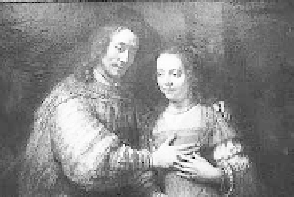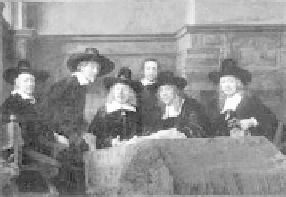Travel Reference
In-Depth Information
Rembrandt's Later Works
Enjoying fame, wealth, and happiness, Rembrandt may have had it
all, but not for long. His wife, Saskia, died. The commissions came
more slowly. The money ran out. His mother died. One by one, his
sons died. He had to auction off his paintings and furniture to pay
debts. He moved out of his fine house to a cheaper place. His bitter
losses added a new wisdom to his work.
Rembrandt—
Isaac and Rebecca
(a.k.a.
The Jewish Bride,
1667)
The man gently draws the woman toward him. She's comfortable
enough with him to sink into thought, and she reaches up uncon-
sciously to return the gentle touch.
They're young but wizened. This
uncommissioned portrait (known
as
The Jewish Bride,
though the
subject is unknown)
is a truly
human look at the relationship
between two people in love. They
form a protective pyramid of love
amid a gloomy background. The
touching hands form the center of this somewhat sad but peaceful
work. Van Gogh said, “Rembrandt alone has that tenderness—the
heartbroken tenderness.”
Rembrandt was a master of oil painting. In his later years, he
rendered details with a messier, more Impressionistic style. The
red-brown-gold of their clothes is a patchwork of oil laid on thick
with a palette knife.
Rembrandt—
The Syndics of the Amsterdam Drapers'
Guild
(De Staalmeesters,
1662)
While commissions were rarer, Rembrandt could still paint an
official group portrait better than anyone. In the painting made
famous by Dutch Masters
cigars, he catches the Drapers
Guild in a natural but digni-
fied pose (dignified, at least,
until the guy on the left sits
down in his friend's lap).
It's a business meeting,
and they're all dressed in
black with black hats—the
standard power suit of the Golden Age. They gather around a table
examining the company's books. Suddenly, someone walks in (us),
and they look up. It's as natural as a snapshot, though X-rays show
Rembrandt made many changes in posing them perfectly.





















